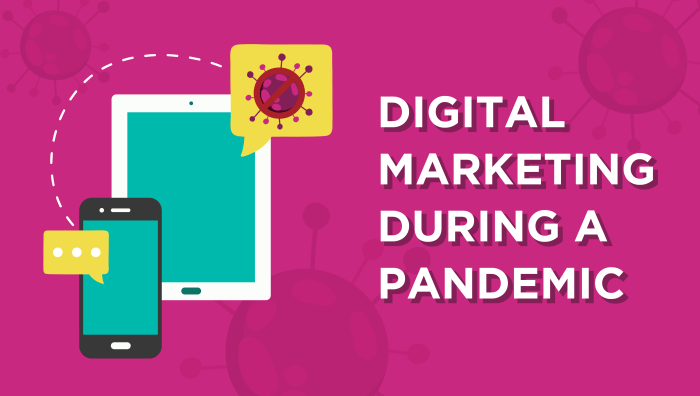Maintaining marketing through a pandemic required innovative strategies and a deep understanding of shifting consumer behavior. This comprehensive guide explores the challenges and opportunities faced by businesses during this period, providing actionable insights into adapting marketing strategies, maintaining brand relevance, optimizing digital channels, managing resources, measuring success, and planning for the post-pandemic landscape. From pivoting strategies to navigating budget constraints, we’ll examine how companies successfully navigated this unprecedented time.
The pandemic forced a rapid shift in consumer behavior, moving many interactions online. Marketers had to quickly adapt to these changes, leveraging digital channels and understanding new customer needs. This guide will break down the key strategies and considerations for effective pandemic marketing, providing examples and data to support each point. The changing landscape demanded innovative solutions, and this guide is designed to empower marketers with those solutions.
Adapting Marketing Strategies During Pandemic Impacts
The COVID-19 pandemic significantly altered consumer behavior and forced businesses to adapt their marketing strategies. Maintaining brand relevance and customer engagement required a shift from traditional methods to more agile and targeted approaches. This necessitated a deep understanding of the changing landscape, from the rise of e-commerce to evolving communication styles. Businesses that successfully navigated this period often saw increased customer loyalty and brand recognition.Understanding the shifts in consumer behavior and business practices during the pandemic provides valuable insights for future marketing strategies.
Analyzing what worked, what failed, and how businesses adjusted helps create more effective and resilient marketing plans, especially in times of uncertainty.
Effective Marketing Strategies During the Pandemic
The pandemic accelerated the adoption of digital channels. Businesses that leveraged online platforms, such as social media and e-commerce, saw substantial success. This involved targeted advertising campaigns, personalized content, and building a strong online presence. For instance, businesses offering online ordering, delivery, and virtual consultations thrived.
Shift in Consumer Behavior and Marketing Adjustments
Consumer behavior shifted dramatically. Increased reliance on online shopping, digital entertainment, and information sources became commonplace. Marketers responded by focusing on digital marketing strategies, emphasizing online customer service, and creating content that addressed consumer anxieties and needs. They adapted their messaging to reflect the current mood and circumstances. For example, brands previously focused on in-person events shifted to virtual webinars and online workshops.
Ineffective Marketing Strategies and Rationale
Some traditional marketing strategies proved less effective during the pandemic. Outages of offline marketing, such as print ads and billboards, were seen as ineffective, as the pandemic reduced the impact and reach. Businesses relying heavily on in-person events and traditional advertising saw diminished returns. This is because consumers were spending less time in public spaces and were less engaged with traditional advertising formats.
Business Pivots to Maintain Relevance
Businesses that pivoted their marketing efforts to remain relevant during the pandemic often saw success. For instance, companies shifted their messaging to focus on customer needs and concerns related to safety, health, and economic stability. Businesses also created or expanded their online presence and adapted their services to accommodate online interactions. This often included creating new product offerings that addressed emerging trends, such as telehealth and online education.
Comparison of Pre-Pandemic and Pandemic-Era Marketing Approaches
| Strategy | Pre-Pandemic Approach | Pandemic Approach | Rationale |
|---|---|---|---|
| Digital Marketing | Growing, but less central | Centralized, integral to operations | Increased consumer reliance on digital channels. |
| Social Media Marketing | Used for brand awareness | Used for direct sales, community building, and crisis communication | Social media became a crucial platform for connection and engagement. |
| Content Marketing | Focused on general brand awareness | Focused on addressing consumer needs and anxieties | Content needed to reflect the evolving environment and address immediate concerns. |
| Advertising | Mostly offline | Primarily online, targeted ads | Consumers were less exposed to traditional advertising. |
| Customer Service | In-person and phone | Online and digital channels | Consumers increasingly expected online support and engagement. |
Maintaining Brand Relevance and Customer Engagement: Maintaining Marketing Through A Pandemic
Navigating a pandemic demanded more than just adapting marketing strategies; it required fostering a deep connection with customers. Maintaining brand relevance and engaging customers during a crisis demanded empathy, understanding, and a shift towards digital channels. Brands that successfully navigated this period prioritized building trust and demonstrating a genuine concern for their audience.Maintaining a sense of connection was crucial in a time of uncertainty.
Brands that prioritized empathy and understanding during the pandemic demonstrated a commitment to their customers, fostering loyalty and positive brand perception. This was not simply a matter of adapting, but of evolving to meet a new set of customer needs and expectations.
Strategies for Maintaining Brand Connection
Brands utilized various strategies to maintain customer engagement and relevance. These ranged from offering support and assistance to providing valuable content and fostering a sense of community. Understanding the evolving needs of customers during the pandemic was critical to maintaining brand relevance.
Navigating marketing during a pandemic was tricky, but adapting was key. Suddenly, businesses needed to rethink strategies, and the recent Google backlash regarding the California privacy bill google backlash california privacy bill highlights a critical shift in consumer expectations. Companies need to prioritize data privacy and transparency, and this directly impacts how marketing strategies need to be adjusted to stay relevant and effective in the current climate.
Digital Channels for Customer Engagement
Businesses quickly leveraged digital channels to stay connected with their customers. Social media platforms, online communities, and email marketing became essential tools for communication and engagement. This shift highlighted the importance of digital channels in modern marketing.
Examples of Successful Brand Communication
Numerous brands demonstrated exceptional communication during the pandemic. Companies like [Example Brand 1] used their platform to provide helpful resources and information on managing the pandemic. [Example Brand 2] employed social media to create a sense of community and support among their followers. These examples illustrate how brands could successfully engage customers during challenging times.
Empathy and Understanding During a Crisis
Demonstrating empathy and understanding is paramount during a crisis. Customers appreciate brands that acknowledge the difficulties they face and offer support. This understanding fosters trust and loyalty, strengthening the brand-customer relationship.
Examples of Communicating Empathy and Understanding
Several brands effectively communicated empathy and understanding to their customers. [Example Brand A] issued statements acknowledging the anxieties and challenges faced by their customer base, showing empathy for the broader situation. [Example Brand B] adjusted their offerings to better serve customers during the pandemic, demonstrating understanding and adaptability. These examples illustrate how empathy can strengthen brand-customer relationships during crises.
Communication Channels and Effectiveness
| Channel | Description | Engagement Metrics | Example |
|---|---|---|---|
| Social Media (Facebook, Instagram, Twitter) | Real-time updates, Q&A sessions, behind-the-scenes content | Increased follower engagement, higher post reach, positive sentiment | [Example Brand C] hosted daily live Q&A sessions on Instagram to address customer concerns regarding product availability. |
| Email Marketing | Personalized messages, valuable content, updates on company initiatives | Higher open rates, increased click-through rates, improved customer retention | [Example Brand D] sent weekly newsletters featuring articles on coping strategies and pandemic-related advice. |
| Website | Dedicated pandemic resource pages, FAQs, updated contact information | Increased website traffic, higher time spent on site, improved customer service | [Example Brand E] created a dedicated landing page on their website providing information on their updated shipping policies and FAQs. |
| Community Forums/Online Communities | Creating online spaces for customers to connect and share experiences | Higher participation in discussions, stronger community bonds, increased customer loyalty | [Example Brand F] launched a dedicated online forum where customers could share experiences, advice, and support one another. |
Optimizing Digital Marketing Channels in a Pandemic
The pandemic drastically accelerated the shift towards digital interactions, forcing businesses to adapt and optimize their marketing strategies. This shift presented both challenges and opportunities, requiring marketers to leverage digital channels more effectively to reach and engage customers. The ability to adapt quickly to the evolving landscape became paramount for maintaining brand relevance and customer engagement.The increased reliance on digital channels during the pandemic was driven by the need for remote work, social distancing, and a significant rise in online shopping.
Navigating marketing during a pandemic requires some serious pivoting. Adapting your strategies is key, and one often-overlooked element is optimizing your website’s usability. For instance, learning how to add a sitenote to your site can greatly enhance user experience and provide crucial information during these challenging times. how to add sitenote This, in turn, helps maintain customer engagement and keeps your marketing efforts relevant and effective.
Staying flexible and proactive is vital in keeping your marketing efforts afloat throughout a pandemic.
This transition necessitated a thorough evaluation of existing digital marketing strategies and a proactive approach to optimizing them for maximum impact.
Digital Marketing Channel Usage During the Pandemic
The pandemic dramatically increased the usage of digital marketing channels. Businesses recognized the critical role these channels played in connecting with customers, particularly those who were now working and shopping remotely. Email marketing, social media marketing, search engine optimization (), and online advertising became even more crucial for maintaining customer engagement.
Importance of Digital Marketing for Remote Customers
Reaching remote customers became significantly more important during the pandemic. With physical stores closed or with limited access, businesses had to rely heavily on digital channels to maintain customer relationships and drive sales. Digital marketing allowed businesses to connect with customers across geographical boundaries, fostering a sense of accessibility and continuity. This was particularly vital for companies selling products or services that were no longer dependent on brick-and-mortar locations.
Optimizing Online Advertising Campaigns
Optimizing online advertising campaigns during the pandemic required a focus on targeted campaigns, precise audience segmentation, and real-time performance monitoring. Marketers needed to adapt their advertising strategies to reflect changing customer behaviors and preferences. For instance, A/B testing different ad creatives and landing pages proved crucial to understanding which approaches resonated most effectively with remote audiences. Utilizing data analytics tools to monitor campaign performance in real-time was essential to adjust spending and optimize ad placement to maximize ROI.
Effectiveness of Different Digital Marketing Channels
Different digital marketing channels exhibited varying levels of effectiveness during the pandemic. Social media platforms, especially those with high user engagement, often saw increased usage. Email marketing remained a crucial channel for maintaining customer relationships, while strategies focused on driving organic traffic proved to be essential for businesses looking to improve their online presence.
Table Illustrating Digital Marketing Channel Growth/Decline
| Channel | Pre-Pandemic Usage | Pandemic Usage | Growth/Decline Rationale |
|---|---|---|---|
| Search Engine Optimization () | Moderate | High | Increased focus on online searches and organic traffic as physical stores were closed or limited. |
| Social Media Marketing | Growing | Very High | Increased use of social media for communication, engagement, and promotion. |
| Email Marketing | High | High | Maintained as a critical channel for communication and promotions. |
| Paid Online Advertising | Moderate | High | Targeted advertising became more important to reach specific audiences during the pandemic. |
| Content Marketing | Growing | High | Importance of providing informative and engaging content increased as people spent more time online. |
| Influencer Marketing | Emerging | Moderate to High | Leveraged to reach specific audiences and drive engagement, with a focus on trusted influencers. |
Managing Budgets and Resources Effectively

The pandemic significantly impacted marketing budgets, forcing businesses to adapt and prioritize spending. Many organizations had to reassess their strategies, focusing on cost-effectiveness and efficient resource allocation to maintain brand visibility and customer engagement. This necessitated a shift towards digital channels and a more data-driven approach to marketing.Economic uncertainty often leads to reduced marketing budgets. Businesses needed to find ways to maximize the impact of their remaining funds.
This required a creative approach to campaign development and a keen understanding of which channels provided the highest return on investment (ROI). Successful companies in this environment were those who were able to make the most of their limited resources, and those who could identify the most cost-effective marketing strategies.
Budget Management Strategies During the Pandemic
Businesses often reduced marketing spend in response to pandemic-related economic downturns. Many organizations shifted focus to cost-effective digital marketing channels. This included optimizing existing social media campaigns, leveraging content marketing to drive organic traffic, and focusing on targeted advertising rather than broad-based campaigns. The shift highlighted the importance of data-driven decisions and measurable results.
Cost-Effective Marketing Strategies
Cost-effective marketing strategies became paramount during the pandemic. Utilizing social media marketing tools for free or low-cost engagement, focusing on content marketing that generated organic traffic, and running targeted ads rather than broad campaigns were all effective ways to maximize ROI. The ability to tailor messages to specific demographics and interests became a key differentiator for businesses.
Innovative Resource Utilization
Innovative use of limited resources was crucial. For instance, businesses repurposed existing content into different formats to extend its reach, and leveraged employee networks for marketing outreach. Crowdsourcing for content ideas or social media engagement was also a practical approach. The key was identifying resourceful ways to expand reach without exceeding budget limitations.
Impact of Reduced Budgets on Campaign Strategies
Reduced marketing budgets forced businesses to prioritize specific campaign goals. This involved focusing on campaigns that yielded the highest return on investment. Companies had to make difficult choices about which marketing channels to maintain and which to temporarily suspend. This necessitated a deep understanding of ROI and the ability to quickly adjust strategies as needed.
Cost-Saving Strategies for Marketing
| Strategy | Description | Estimated Savings | Return on Investment |
|---|---|---|---|
| Content Repurposing | Transforming existing content into different formats (e.g., blog posts into infographics, videos into social media posts) to maximize reach. | $1000 – $5000+ | Increased website traffic, engagement, and brand awareness. |
| Social Media Optimization | Improving social media profiles and content to enhance organic reach and engagement, including using free tools and resources. | $500 – $2000+ | Higher engagement, brand awareness, and potential leads. |
| Targeted Advertising | Focusing on specific demographics and interests in advertising campaigns, avoiding broad-based campaigns. | $1000 – $10,000+ | Increased conversion rates and reduced wasted ad spend. |
| Employee Advocacy Programs | Encouraging employees to share company content and updates on their personal social media channels. | Free | Increased brand visibility and reach within employee networks. |
Measuring Marketing Success During the Pandemic
Navigating the unpredictable landscape of a pandemic required marketers to rethink their strategies, not just their tactics. Adapting to lockdowns, social distancing, and shifting consumer behavior demanded a fundamental shift in how success was measured. The old metrics simply weren’t reflecting the new realities. Businesses needed a more nuanced and agile approach to evaluating the impact of their marketing efforts.
Adapting Marketing Measurement Methods
Traditional marketing metrics, such as website traffic and lead generation, often became less relevant during the pandemic. Consumers’ online behavior changed dramatically, and physical store visits were often restricted. This meant marketers had to look beyond these traditional indicators and focus on metrics that reflected the evolving customer journey and the changing ways people interacted with brands. This involved a more granular understanding of customer engagement, brand perception, and the impact of digital touchpoints.
For instance, engagement metrics on social media, online reviews, and customer service interactions became critical indicators of success.
Tracking Key Performance Indicators (KPIs)
Businesses responded by tracking a wider range of KPIs. For example, instead of solely focusing on website visits, marketers analyzed the time spent on site, conversion rates, and the quality of leads generated. They also monitored social media engagement, such as likes, shares, comments, and mentions. Analyzing customer feedback through online reviews and surveys became vital to understanding customer sentiment and identifying areas for improvement.
In addition to these digital metrics, some businesses also looked at sales data to gauge the impact of their campaigns. By focusing on these comprehensive metrics, marketers could gain a more accurate picture of how their campaigns were performing in the face of the evolving circumstances.
Challenges in Measuring Marketing Success
Several challenges arose in measuring marketing success during the pandemic. The unpredictability of the situation made it difficult to establish consistent benchmarks. Shifting consumer behavior made it hard to predict future trends, thus making it harder to evaluate the long-term impact of marketing campaigns. Furthermore, data collection and analysis became more complex due to the rapid increase in online activity and the need for real-time insights.
Navigating marketing during a pandemic required serious pivots. Understanding how revenue operations, or RevOps, plays a critical role in achieving growth is key. RevOps ensures smooth processes and data-driven decisions, which is essential for adapting marketing strategies. For instance, optimizing lead generation and customer acquisition needs a robust RevOps function to effectively manage resources. This function ultimately allows you to maintain and improve your marketing strategy even when the world is in upheaval.
Read more about why revenue operations revops is an important growth function here.
Measuring the impact of marketing on offline sales was also more difficult due to the limitations on in-person interactions and physical store visits.
Understanding and Responding to Evolving Customer Needs
Data played a crucial role in understanding and responding to changing customer needs. Analyzing website traffic data, social media sentiment, and online search trends provided insights into what customers were looking for and how their needs had shifted. This allowed businesses to tailor their messaging, products, and services to better meet the demands of the current situation. For instance, if online sales of certain products surged, businesses could adjust their marketing efforts to prioritize promoting those items.
Similarly, a rise in negative sentiment on social media regarding a specific aspect of customer service could prompt immediate action to address those concerns.
Key Performance Indicators (KPIs) Used to Measure Marketing Success
| KPI | Definition | Measurement Method | Significance |
|---|---|---|---|
| Website Traffic | Number of visitors to a website. | Website analytics tools (e.g., Google Analytics). | Indicates overall visibility and reach. |
| Conversion Rate | Percentage of visitors who complete a desired action (e.g., making a purchase). | Website analytics tools. | Measures effectiveness of marketing in driving desired outcomes. |
| Customer Engagement | Level of interaction with brand content. | Social media analytics, website interaction data, customer surveys. | Indicates brand resonance and customer satisfaction. |
| Brand Sentiment | Public perception of a brand. | Social media monitoring tools, online reviews, customer feedback surveys. | Reflects overall brand health and effectiveness of communication. |
Post-Pandemic Marketing Strategies

The pandemic forced businesses to re-evaluate their marketing strategies, adapting to a dramatically altered consumer landscape. This shift presented challenges, but also opportunities for innovation and a deeper understanding of customer needs. Businesses that successfully navigated the crisis emerged with a more agile and customer-centric approach, setting the stage for a new era of marketing.The post-pandemic era saw a fundamental shift in how businesses interacted with their customers.
Companies that had previously relied heavily on traditional marketing methods realized the crucial importance of digital channels and data-driven insights. This newfound reliance on digital platforms became a key factor in shaping post-pandemic marketing strategies.
Examples of Post-Pandemic Marketing Adjustments
Businesses incorporated lessons from the pandemic into their post-pandemic strategies in various ways. Many retailers, for instance, recognized the growing preference for online shopping and adapted their websites and e-commerce platforms to improve user experience. This included enhancements in website navigation, product information, and secure payment processing. Furthermore, businesses emphasized the importance of personalized customer experiences, using data analytics to tailor messaging and offers to individual needs.
This allowed for more relevant interactions, building stronger customer relationships.
Evolution of Marketing Approaches Post-Pandemic, Maintaining marketing through a pandemic
Marketing approaches evolved significantly after the pandemic. The shift from traditional to digital channels became more pronounced. Companies prioritized building stronger online presences, enhancing their digital marketing strategies, and creating personalized experiences for customers. Increased use of social media, targeted advertising, and personalized content became integral components of post-pandemic marketing strategies.
Adapting to the “New Normal”
Companies adapted to the “new normal” by recognizing and responding to evolving consumer behaviors. The pandemic revealed a heightened awareness of sustainability and social responsibility, and companies adjusted their marketing efforts accordingly. Emphasis on ethical practices, environmental concerns, and social impact became key elements in attracting and retaining customers. Many businesses integrated these values into their branding and messaging, demonstrating a commitment to a more sustainable and responsible approach.
New Opportunities in the Post-Pandemic Market
The post-pandemic market presents unique opportunities for effective marketing. The rise of remote work and online shopping created new avenues for engaging with customers. Businesses capitalized on these trends by developing targeted marketing campaigns, creating personalized experiences, and building online communities. Businesses also leveraged the data they collected during the pandemic to understand customer preferences and adjust their strategies accordingly.
This provided opportunities for more effective targeting and personalized communication.
Table: Marketing Strategy Adjustments Post-Pandemic
| Pre-Pandemic Strategy | Pandemic Adaptation | Post-Pandemic Adjustment | Rationale |
|---|---|---|---|
| Primarily focused on print and television advertising | Developed a robust online presence and adapted campaigns to digital channels | Prioritized digital marketing through , social media, and targeted advertising | Increased reach and engagement through online channels, reflecting changing consumer habits |
| Limited use of data analytics for marketing | Used data analytics to understand customer behavior during lockdowns and restrictions | Integrated data analytics into every aspect of marketing, creating personalized customer experiences | Improved marketing efficiency and effectiveness by tailoring campaigns to individual customer needs |
| Traditional customer service methods | Implemented online customer support and virtual consultations | Combined online and offline support channels, creating a seamless experience | Enhanced customer experience by offering convenient and flexible support options |
Epilogue
In conclusion, maintaining marketing through a pandemic required adaptability, resourcefulness, and a deep understanding of the evolving market. Businesses that successfully navigated this period often combined traditional strategies with digital solutions, prioritized customer engagement, and utilized data to make informed decisions. The strategies discussed in this guide offer a roadmap for future marketing efforts, helping companies prepare for unexpected challenges and leverage opportunities in a rapidly changing world.
Ultimately, resilience and a willingness to adapt were crucial for success.






